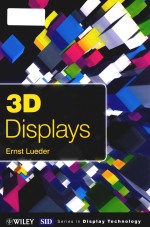
- 作 者:Ernst Lueder
- 出 版 社:Wiley
- 出版年份:2012
- ISBN:111999151X
- 标注页数:264 页
- PDF页数:275 页
请阅读订购服务说明与试读!
订购服务说明
1、本站所有的书默认都是PDF格式,该格式图书只能阅读和打印,不能再次编辑。
2、除分上下册或者多册的情况下,一般PDF页数一定要大于标注页数才建议下单购买。【本资源275 ≥264页】
图书下载及付费说明
1、所有的电子图书为PDF格式,支持电脑、手机、平板等各类电子设备阅读;可以任意拷贝文件到不同的阅读设备里进行阅读。
2、电子图书在提交订单后一般半小时内处理完成,最晚48小时内处理完成。(非工作日购买会延迟)
3、所有的电子图书都是原书直接扫描方式制作而成。
1 The Physiology of 3D Perception 1
1.1 Binocular Viewing or Human Stereopsis 1
1.2 The Mismatch of Accommodation and Disparity and the Depths of Focus and of Field 3
1.3 Distance Scaling of Disparity 6
1.4 Interocular Crosstalk 7
1.5 Psychological Effects for Depth Perception 10
1.6 High-Level Cognitive Factor 10
Acknowledgments 11
References 11
2 Stereoscopic Displays 13
2.1 Stereoscopic Displays with Area Multiplexing 13
2.1.1 Retarders for the generation of polarizations 13
2.1.2 Wire grid polarizers for processing of the second view 20
2.1.3 Stereoscopic display with two LCDs 22
2.2 Combined Area and Time Division Multiplex for 3D Displays 26
2.3 Stereoscopic Time Sequential Displays 31
2.3.1 Time sequential viewing with an active retarder 31
2.3.2 Fast time sequential 3D displays by the use of OCB LCDs 33
2.3.3 Time sequential 3D displays with black insertions 33
2.4 Special Solutions for Stereoscopic Displays 41
2.5 Stereoscopic Projectors 48
2.6 Interleaved,Simultaneous,and Progressive Addressing of AMOLEDs and AMLCDs 60
2.7 Photo-Induced Alignment for Retarders and Beam Splitters 68
Acknowledgments 68
References 69
3 Autostereoscopic Displays 73
3.1 Spatially Multiplexed Multiview Autostereoscopic Displays with Lenticular Lenses 73
3.2 Spatially Multiplexed Multiview Autostereoscopic Displays with Switchable Lenticular Lenses 85
3.3 Autostereoscopic Displays with Fixed and Switchable Parallax Barriers 95
3.4 Time Sequential Autostereoscopic Displays and Directional Backlights 104
3.4.1 Time sequential displays with special mirrors or 3D films 105
3.4.2 Time sequential displays with directionally switched backlights 109
3.5 Depth-Fused 3D Displays 115
3.6 Single and Multiview 3D Displays with a Light Guide 125
3.7 Test of 3D Displays and Medical Applications 129
Acknowledgments 129
References 130
4 Assessment of Quality of 3D Displays 133
4.1 Introduction and Overview 133
4.2 Retrieving Quality Data from Given Images 135
4.3 Algorithms Based on Objective Measures Providing Disparity or Depth Maps 136
4.3.1 The algorithm based on the sum of absolute differences 136
4.3.2 Smoothness and edge detection in images 140
4.4 An Algorithm Based on Subjective Measures 146
4.5 The Kanade-Lucas-Toman (KLT) Feature Tracking Algorithm 153
4.6 Special Approaches for 2D to 3D Conversion 158
4.6.1 Conversion of 2D to 3D images based on motion parallax 159
4.6.2 Conversion from 2D to 3D based on depth cues in still pictures 161
4.6.3 Conversion from 2D to 3D based on gray shade and luminance setting 162
4.7 Reconstruction of 3D Images from Disparity Maps Pertaining to Monoscopic 2D or 3D Originals 165
4.7.1 Preprocessing of the depth map 165
4.7.2 Warping of the image creating the left and the right eye views 167
4.7.3 Disocclusions and hole-filling 172
4.7.4 Special systems for depth image-based rendering (DIBR) 176
Acknowledgments 182
References 183
5 Integral Imaging 185
5.1 The Basis of Integral Imaging 186
5.2 Enhancement of Depth,Viewing Angle,and Resolution of 3D Integral Images 188
5.2.1 Enhancement of depth 189
5.2.2 Enlargement of viewing angle 193
5.2.3 Enhancing resolution 195
5.3 Integral Videography 196
5.4 Convertible 2D/3D Integral Imaging 207
Acknowledgments 214
References 214
6 Holography for 3D Displays 217
6.1 Introduction and Overview 217
6.2 Recording a Hologram and Reconstruction of the Original 3D Image 218
6.3 A Holographic Screen 227
6.4 Digital Holography Based on the Fourier Transform 229
6.5 A Holographic Laser Projector 232
Acknowledgments 235
References 235
7 Volumetric 3D Displays 237
7.1 The Nature of Volumetric Displays 237
7.2 Accessing and Activating Voxels in Static Volumetric Displays 238
7.3 Swept Volume or Mechanical 3D Displays 245
Acknowledgments 252
References 252
8 A Shot at the Assessment of 3D Technologies 253
Index 257
